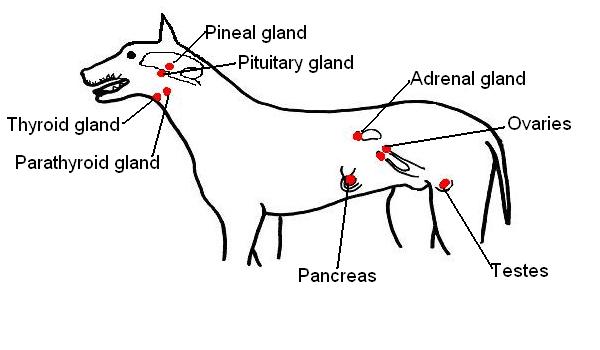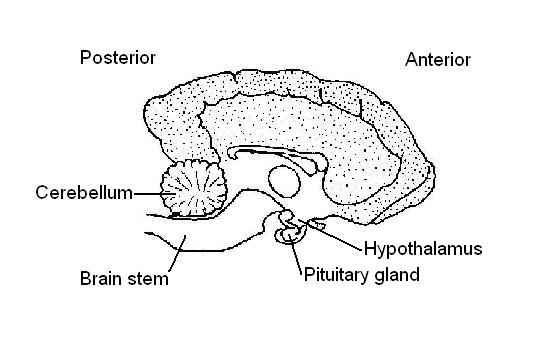The Anatomy and Physiology of Animals/Endocrine System Worksheet/Worksheet Answers
From WikiEducator
1. Fill in the gaps in the sentences below using the words in the list.
- target; blood system; ducts; hormones
- a. Endocrine glands release their secretions directly into the blood. In other words they have no ducts.
- b. Endocrine glands secrete chemicals called hormones.
- c. Hormones are transported from the endocrine glands to all parts of the body by the blood system.
- d. Although hormones are carried throughout the body they only affect specific target organs and tissues
2. The position of endocrine organs have been indicated in red on the diagram of a composite male and female dog shown below. Add the labels in the list to the diagram.
- Ovary; Pancreas; Thyroid gland; Pituitary gland; Testis; Adrenal gland; Pineal gland; Parathyroid gland
3. On the diagram of the brain below indicate the position of the Hypothalamus and Pituitary gland.
4. In the table below list 3 hormones produced by the pituitary gland and state the function of each.
| Hormone | Function |
|---|---|
| 1.Growth hormone. | Stimulates growth of the body by increase in length of the long bones |
| 2.Oxytocin | Stimulates milk "let down" |
| 3.Follicle stimulating hormone (FSH) | Stimulates the development of the ovarian follicle. |
| Plus: Luteinising hormone(LH) | Stimulates development of the corpus luteum of the ovary |
| Plus: Antidiuretic hormone (ADH) | Stimulates the production of concentrated urine |
| Plus some others |
5. Fill in the following table with the endocrine organ the hormones are produced by.
| Hormone | Produced by: |
|---|---|
| Insulin | Pancreas |
| Progesterone | Corpus luteum |
| Oestrogen | Ovarian follicle |
| Growth hormone | (Anterior) pituitary gland |
| Adrenaline | Adrenal medulla |
| Antidiuretic hormone | (Posterior) pituitary gland |
| Testosterone | Testis |
| Aldosterone | Adrenal cortex |
| Melatonin | Pineal gland |
| Oxytocin | (Posterior) pituitary gland |
| Thyroxine | Thyroid gland |
6. Match the hormones in the list below with their functions.
- Oxytocin; Insulin; Oestrogen; Growth hormone; Antidiuretic hormone; Testosterone; Adrenaline; Cortisone; Melatonin; Progesterone; Thyroxine; Luteinising hormone; Follicle stimulating hormone
| Hormone | Function |
|---|---|
| Follicle stimulating hormone (FSH) | 1. Stimulates development of the ovarian follicle. |
| Oxytocin | 2. Stimulates milk “let down”. |
| Insulin | 3. Controls blood glucose levels. |
| Thyroxine | 4. Influences the rate of growth and development of young animals. |
| Growth hormone | 5. Stimulates the growth of long bones. |
| Antidiuretic hormone (ADH) | 6. Stimulates absorption of water from the kidney tubule. |
| Melatonin | 7. Influences the development of sexual maturity. |
| Luteinising hormone (LH) | 8. Stimulates the development of the corpus luteum. |
| Oestrogen | 9. Stimulates the development of female sexual characteristics. |
| Testosterone | 10. Stimulates the development of the male sexual characteristics. |
| Cortisone | 11. Affect glucose, protein and fat metabolism. |
| Progesterone | 12. Prepares the lining of the uterus for pregnancy. |
| Adrenaline | 13. Prepares the body for emergency situations. |
7. Circle the odd one out.
- 1. melatonin; oxytocin; growth hormone; antidiuretic hormone; follicle stimulating hormone. Melatonin is the only hormone in the list not produced by the pituitary gland.
- 2. progesterone; oestrogen; luteinising hormone; cortisone; follicle stimulating. Cortisone is the only hormone in the list not involved in any major way with reproduction.
- 3. adrenaline; cortisone; aldosterone, oestrogen, insulin. Insulin is the only hormone in the list not produced by the adrenal gland.

